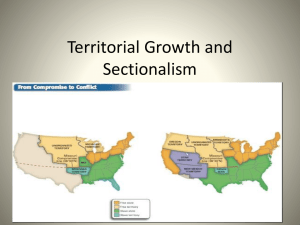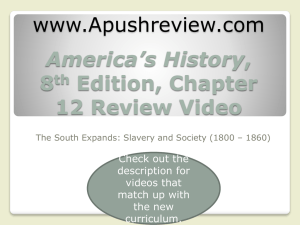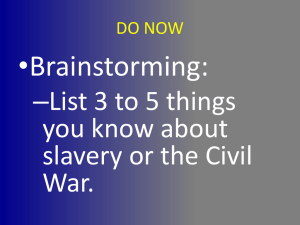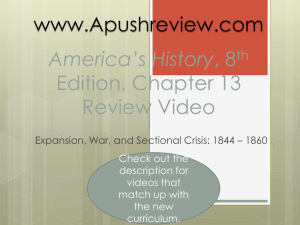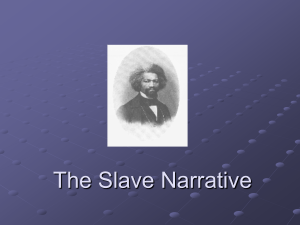Causes of Civil War
advertisement
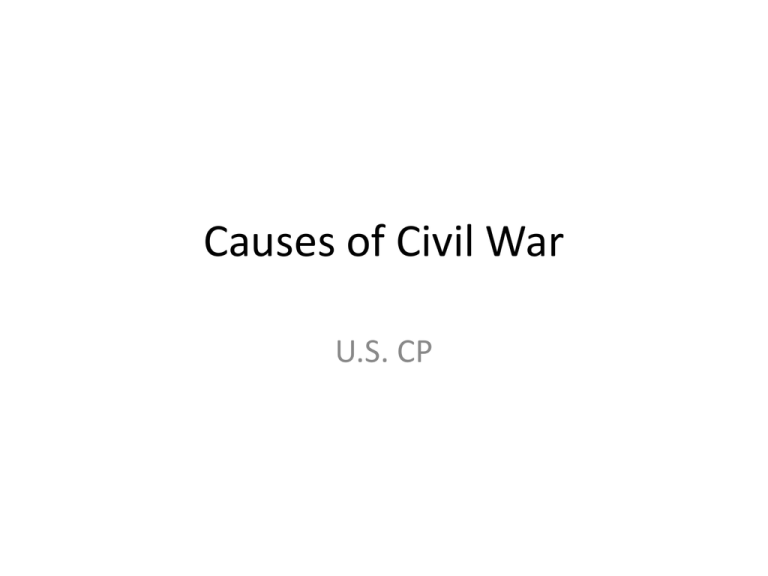
Causes of Civil War U.S. CP Today’s Objectives • Know the sectional differences that existed between the North and the South before the Civil War. • Understand the impact of the cotton gin. • Know what the underground railroad was. • Understand the term “manifest destiny.” • Know how the fugitive slave law created sectional tension. • Understand how westward expansion caused sectional tension. • Know the 2 ways that the U.S. acquired the territory that allowed it to reach the Pacific Ocean. Sectional Differences • As North industrialized and became more modern, the South stayed mostly the same. • U.S. became a country with two different societies. The North – 1. More Populous – 2. More Manufacturing – 3. More cities – 4. More Railroads – 5. Free Labor (wage labor) “Self-Making” South • Mainly Agriculture • Slaves Slavery 1860 The Cotton Gin • Slavery was in decline as crops began to shift from tobacco to wheat in the upper south. • Eli Whitney’s invention (1793) makes cotton a crop that can be grown in the south. • It separates seeds from the cotton. • After the invention of the cotton gin, U.S. South becomes the leading producer of cotton in the world. • Caused an increase in the demand for slaves. Cotton Gin Review • How were the North and South different by the 1840s? • What was the Cotton Gin and how did it impact slavery? Abolitionists • People who oppose slavery – A. Moral grounds – B. Goes against “Self-Making”—the idea that through hard work, individuals can succeed. Key Abolitionists • William Lloyd Garrison—editor of The Liberator. • Frederick Douglass— An escaped Slave. Underground Railroad • “Conductors” help slaves to safe houses until they escape to free territory. • Harriet Tubman is the most famous “conductor.” • Underground RR infuriates many southerners. Uncle Tom’s Cabin • Anti-Slavery novel written by Harriet Beecher Stowe. • Upset many southerners. Review • Who was the most famous abolitonist? • Who was the famous abolitionist that was an ex-slave? • What was the underground railroad? • Who was the most famous conductor of the underground railroad? Fugitive Slave Law • Law that forced Northerners to help in catching runaway slaves. • Fines for helping runaways. • Bonus for returning them. • Angers many Northerners. Sectional Tension over Slavery • Southerners do not like: – A. Underground RR – B. Abolitionists – C. “Uncle Tom’s Cabin” • Northerners do not like: – Fugitive Slave Law – Slavery’s negative impact on white selfmaking Manifest Destiny • Idea that the country is destined to expand to the Pacific. – A. Virtue – B. Mission – C. Destiny • Allows overpopulation to have an outlet to the west. • Term coined by John L. O`Sullivan Westward Expansion • Country acquires more territory: – A. Louisiana Purchase – B. War with Mexico The problem of Westward Expansion • As the country moves west and makes new states, the issue becomes whether the new states should be “free” or “slave.” • Why would people care whether states could have slaves or not? The answer • The South fears that if it doesn’t have the same amount of votes in Congress (The Senate), Northerners will outlaw slavery. • So Southerners feel that there always needs to be the same amount of “slave” and “free” states. • Many Northerners, however, oppose the expansion of slavery. WHY? Warm Up • What were some of the differences between the North and the South before the Civil War? • What was the Cotton gin? Who invented it? And what was its impact? • What was the Underground railroad? • What was the fugitive slave law? • What was Manifest Destiny? • What were the two ways that America acquired territory west of the Mississippi? • How did westward expansion cause tension between the North and the South? Louisiana Purchase • 1803--When Jefferson is President. • US wants to have access to port city of New Orleans so farmers can get crops down the Mississippi River to market. • When US asks to buy city of New Orleans from France, Napoleon offers all of Louisiana territory. • US buys for $15 million • Doubles the size of the US The Missouri Compromise • Missouri applies for statehood in 1819. • At the time there are 11-Free Sates & 11Slave states. • Many slaves already in Missouri. The Compromise • The work of Henry Clay—Speaker of the House from Kentucky. • 1820--Maine would enter the Union as a free sate and Missouri a Slave state. • In the future, slavery would not be allowed in remaining territory above Missouri’s southern border of 36-30. Indian Removal • Another problems with westward expansion was what to do about native Americans. • Whites want native lands so they can farm. • When Andrew Jackson is president, he tells natives they must give up their land and move west of the Mississippi River. The Trail of Tears Texas • Americans invited by Mexican govt. to settle in Texas in 1820s. They are led by Stephen F. Austin. • Soon there were more Americans than Mexicans. • American settlers declared independence in 1836. • Mexican forces ruthlessly try to subdue the rebellion (The Alamo). The Alamo The Alamo • Battle of San Jacinto— Sam Houston captures Santa Anna and Texans get independence. • US won’t take in Texas because it would create controversy (slavery). • Lone Star Republic until 1844 when US finally takes Texas as a state. War with Mexico • Mexico breaks diplomatic ties with US over Texas annexation. • US tries to buy New Mexico and California, but Mexico rejects. • Mexico claims that border of Texas is Nueces River. • America claims it is the Rio Grande. • US President Polk sends forces commanded by Zachary Taylor to “defend” the border. • US claims it was attacked and Congress declares war in 1846. War with Mexico • 1846 – 1848 (US wins) • Winfield Scott captures Mexico City. • Treaty of Guadalupe Hidalgo ends war • US gets California, Arizona, New Mexico, Utah, Nevada, Colorado, and Wyoming. • Also border of Texas is recognized as Rio Grande. • US pays Mexico $15 million. California • 1846--When Mexican War broke out, John C. Fremont led a rebellion of Americans living in CA and declared independence (The Bear Flag Republic). The Gold Rush • 1848—John Marshall— working at Sutter’s Mill — finds gold. • Leads to Gold Rush (49ers). • Most are men—leads to volatile society. • Also many Chinese. Problem with the U.S. winning the war with Mexico • Now new sates will want to enter the union. Should they be free or slave? • Missouri compromise won’t work. • What would you do? Problems of California Statehood • Calif. Applied for statehood in 1849 as a free sate. • The balance between free and slave states was 15 each. • Southerners were opposed and feared other potential new sates—New Mexico, Oregon, Utah—would also enter as free states too. Compromise of 1850 • In 1850 there are 15 free states and 15 slave states. • California wants to enter as free state. • 1. Cal. Enters union as free state. • 2. Utah & New Mexico territories = Popular Sovereignty (the people in the state decide if they want slavery or not). • 3. Outlawed slave trade in Washington D.C. • 4. Called for a stronger fugitive slave law. Kansas - Nebraska Kansas wants to enter the union. • Supposed to be free of slavery because of Missouri Compromise. • 1854 Kansas – Nebraska Act. Territory divided into two—Kansas and Nebraska. • Territories could decide for themselves = popular sovereignty. “Bleeding Kansas” • 1855—Elections held in Kansas. • Pro-slavery people from neighboring Missouri come into the state and vote. • Pro-slavery majority vote to legalize slavery. • Anti-slavery people form their own govt. and outlaw slavery (Lawrence). • There were then two governments in the state—One saying the state is a slave sate, the other saying it’s a free state. • Pro-slavery forces go and “sack” Lawrence. Bleeding Kansas (cont.) • Soon fighting between the two sides began to see who will rule the state. • Is a prelude to the Civil War. “Bleeding Kansas” Birth of Republican Party • Kansas –Nebraska Act led Northern Whigs and many Northern Democrats-who were upset at the repeal of the Missouri Compromise—to form a new party. • 1854—the Republican Party Republican Party’s Ideology • “Free Soil, Free Labor” • They are against the expansion of slavery into the territory west of the Miss. Read Handout • What were the two key rulings handed down by the Supreme Court in the Dred Scott Case? • In other words, What two things about slavery were decided by this case? Dred Scott Case • 1857—Dred Scott v. Sandford • Chief Justice Roger Taney ruled: – A. Scott could not sue because slaves are not citizens, but rather, property. – B. The Missouri Compromise was unconstitutional & thus the fed. Govt. could not say where slavery could or could not be. • Greatly increased sectional tension because it made it seem as if fed. Government could not stop slavery from expanding. Lincoln-Douglas Debates • 1858 Senate race in Illinois. • Series of debates between the candidates—Republican Abe Lincoln and Democrat Stephen Douglas. • Main issue they debate is what to do about the issue of slavery in the western territories. • Douglas win the election, but Lincoln becomes famous throughout the country. Lincoln-Douglas Debates John Brown • Radical Abolitionist. • Leads a raid on Harper’s Ferry (1859). • Wanted to give weapons to slaves so they could rebel. • Is captured and hung. • Anti-slave people call him a martyr. • South considers him to be crazy. The Election of 1860 • Abraham Lincoln, the Republican candidate for President, is against the extension of slavery into the western territories. • Does not think blacks are equal to whites but thinks slavery is bad for white self-making. • Some in the South say that they will secede (leave the Union) If he is elected President. Election of 1860 Lincoln wins • The South secedes. • They form The Confederate Sates of America. • Some southern “Border” states stay in the union.



